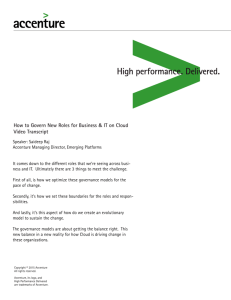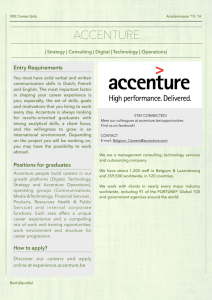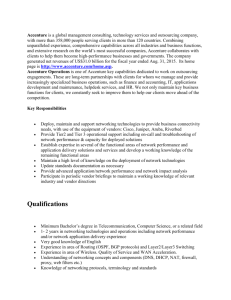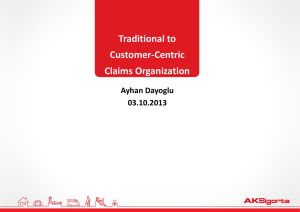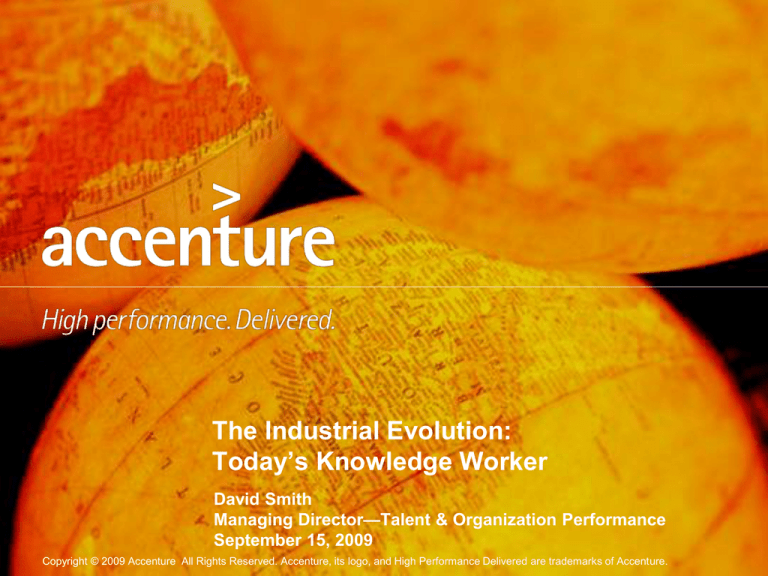
The Industrial Evolution:
Today’s Knowledge Worker
David Smith
Managing Director—Talent & Organization Performance
September 15, 2009
Copyright © 2009 Accenture All Rights Reserved. Accenture, its logo, and High Performance Delivered are trademarks of Accenture.
The World is Changing…
has your organization kept up?
Copyright © 2009 Accenture All Rights Reserved.
2
Headline news: The rise of the
multi-polar world
US documentary extols
superiority of Indian
education system
The sole superpower
in decline: the rise of a
multipolar world
New Kerala.com, Jan 2004
Bnet, 2008
The dollar dilemma:
the worlds top currency
faces competition
September 2009
Copyright © 2009 Accenture All Rights Reserved.
3
Economic power is becoming
more dispersed
Share of global GDP
A changing leader board
Real GDP at 1996 prices, US$ trillion
Real GDP at 2005 prices
CAGR
2005-2025
120
100
61
%
60
57
%
20
0
49
%
29%
39%
71%
61%
51
%
1980
1990
2005
43
%
39
%
2015
2025
Developed
2.7%
40
Emerging
5.8%
80
Source: Economist Intelligence Unit
Emerging World
1990
2007
2025
1
US
US
China
2
Japan
China
US
3
China
India
India
4
Russia
Japan
Japan
5
Germany
Germany
Germany
6
India
UK
Russia
7
France
France
UK
8
UK
Russia
Brazil
9
Italy
Brazil
France
10
Brazil
Italy
South Korea
Developed World
Source: Economist Intelligence Unit
Copyright © 2009 Accenture All Rights Reserved.
4
Driven by three mutually-reinforcing
trends – stressing our ability to respond
Key Trends
• Economic and political opening
Economic
Openness
• 2005: 164/205 regulatory changes in investment regimes
globally positive
• Trade liberalization: WTO*, NAFTA, ASEAN, EU
Increasing Power
of Information &
Communication
Technology
Size & Reach of
Multinationals
• Disaggregation of business functions across geographies
• Globalization of supply chains
• Inclusion of services in global tradables
• Increasing scale of multinationals as catalyst for
multi-polar world
• Increased foreign assets, revenues and employment
*China, Vietnam, Russia (2007/08)
Copyright © 2009 Accenture All Rights Reserved.
5
Five key dimensions demonstrate the
increased economic interdependence of
the multi-polar world
War for talent
Emerging consumers
The flow of capital
Economic
openness
The new map of
innovation
Copyright © 2009 Accenture All Rights Reserved.
Technology
Size & reach of
multinationals
The battle for
resources &
sustainability
6
Consumers …the implications of a billion
new consumers…
New consumer markets – Rise of the ‘B6’
Consumer expenditure (US$ billions)
30,000
B6 = Six biggest
emerging consumer
markets:
G6
B6
25,000
China
India
Brazil
Russia
Mexico
South Korea
20,000
15,000
10,000
5,000
0
2005
Source: EIU
2025
Rise of China’s middle class
Number of households (millions)
23
CAGR:
6
28
77
83
114
260
186
2005
Affluent
29.7%
Middle Class
24.1%
Aspiring
8.3%
Poor
-6.5%
2010
Copyright © 2009 Accenture All Rights Reserved.
• Future growth and scale of
multinationals dependent on
market share in emerging
economies
• Globalization takes on nonWestern characteristics
• Springboard for emerging
market multinationals and
test bed for product and
service innovation
• Adaptation of business
models to suit unique
characteristics of emerging
consumer markets
• Aging population in western
markets has a big impact on
existing brand positioning
Source: EIU
7
Talent …the implications of competing
for a global workforce…
Shift in workforce size
30
Workforce growth %
25
1995 - 2005
20
2005 - 2015
15
10
5
0
EU25
-5
-10
China
US
Russia
South
Korea
Mexico
India
Japan
Brazil
Source: EIU
Global labor force in 2005
B6 = 1,520m
900
800
Developed
economies =
435m
700
600
500
400
300
200
100
• Competing for a global
workforce
• Increased competition in
ability to recruit and retain
role-ready people
• Emergence of differentiated
workforces within
companies
• Local tailoring and execution
of global talent management
strategies (hubs and
spokes)
• Maintaining culture within a
fragmented organization
• Adaptation to the social
fabric of society
0
China
India
Brazil
Russia Mexico
South
Korea
EU25
Copyright © 2009 Accenture All Rights Reserved.
US
Japan
Source: EIU
8
Innovation …the implications of the
globalization of innovation…
Emerging clusters of innovation
Poland
High Tech, Automotive
Russia
Software Engineering
Mexico
Construction
S. Korea
ICT, genomics
Brazil
Biofuels
China
Consumer Products,
Telecoms, PetroChem,
Pharma, Biotech, Nanotech
India
IT, Telecoms, Pharma, Biotech,
Nanotech, Automotive
Taiwan Semiconductors
Diversification of R&D locations
Survey: Most attractive locations for R&D (2005-2009)
(% of responses identifying country as one of top three most attractive)
70
• Local cluster participation
(fabric of society)
• R&D located closer to target
markets
• Distributed innovation –
deconstruction of value
chains
• Strategic bets in particular
sectors and regions
• Nimbleness in moving
functions to take advantage
of relative R&D advantages
60
50
40
30
20
10
0
China
US
India
UK
Russia
Copyright © 2009 Accenture All Rights Reserved.
Source: UNCTAD,
World Investment Report, 2005
9
Capital …the implications of multidirectional
capital flows…
Growth of emerging economy FDI
B6 inflows and outflows 2002-2005 (US$ billions)
160
140
120
CAGR
B6 FDI Outflows
B6 FDI Inflows
40.7%
100
80
14.5%
60
40
20
0
2002
2003
2004
Source: UNCTAD
2005
Emerging market MNCs
• Advent of emergingeconomy multinationals
• Increased competition in
(and susceptibility to) global
M&A
• New sources of equity and
debt finance
• Frontier thinking on “foreign”
ownership and capital
movement
Composition of the Global Fortune 500
500
20
70
100+
Emerging
market
MNCs
400
300
Developed
MNCs
200
100
0
1995
2006
2016
Copyright © 2009 Accenture All Rights Reserved.
Source: Fortune Magazine
10
Resources …the implications of the battle
for resources…
• Sophistication of resource
procurement
• Diversification of sources
and resources
• Increasing importance of
environmental impact and
sustainability
Growing demand
Global energy consumption 1980-2030
(quadrillion British thermal units)
800
700
600
500
400
300
200
100
0
1980
1985
1990
1995
2003
2010
2015
2020
2025
2030
Global Oil Consumption
Sources of growth in global primary energy* consumption 2001-2006
Africa, 3.0%
South & Central
America, 5.0%
North America,
8.0%
Middle East,
9.0%
China, 46.0%
Europe &
Eurasia, 11.0%
* oil, coal, natural gas, nuclear and hydro electricity
Other Asia
Pacific, 18.0%
Source: BP Statistical Review of World Energy 2007
Copyright © 2009 Accenture All Rights Reserved.
11
Organizations will look different – what is
your organization doing about it?
• Additional centers of decisionmaking
• Innovation and investment clusters
• Buying patterns – scope, scale and
frequency
• Diversity within workforces
• Diversity of risk tolerance
• Diversity in corporate culture
• New influences in global business
ethics
• Added reach and complexity of
supply chains
Copyright © 2009 Accenture All Rights Reserved.
12
The changing demographics of the new
knowledge worker
Four Generations in the workforce –
with a heavy influence from the Net Generation
Entry into Workforce
Retirement
Employer Loyalty
Silent Gen1
(1925 – 1942)
Baby Boomers1
(1943 – 1960)
Generation X1
(1961 – 1981)
Generation Y
Net Generation2
(1982 – 1998)
Tenure
Copyright © 2009 Accenture All Rights Reserved.
Source:
1 Howe, Neil; Life Course Associates, 2007.
2 New Paradigm – Net Generation Strategic Investigation;
2007; co-sponsored by Accenture
13
Meet your new workforce
the Net Generation
The most populous generation
with the greatest global reach
• Prefer flexible hours and
compensation based on individual
performance & market value
• Internet is their primary means of
communication
• Don’t take well to hierarchy and
authoritarian management
• Expect to be involved in decision
making
Copyright © 2009 Accenture All Rights Reserved.
14
Meet your new workforce
the Net Generation
• Respect authority, but in case
of a conflict they approach
management directly to resolve it
• Achievement-oriented
• Loyal to their vision of their career
path, but not to a particular
employer
Copyright © 2009 Accenture All Rights Reserved.
15
Knowledge Workers and the use of
Web 2.0 – Anywhere, Anytime
Bulletin Boards
Email
Instant
Messaging
Web Meetings
Static Pages
Search Engine
Tagging
Filtering
Content
Management.
Portals
Deep Web
Dynamic Web
Reading and Doing
Voice Mail
Mobile
SMS
Mobile
Collaboration.
Talking and Listening
Copyright © 2009 Accenture All Rights Reserved.
Writing and Sharing
Searching and Finding
16
The Impact on the organization…
Data Transparency
Increased Participation
Dynamic Intelligence
Power Balance
Learner Expectations
Natural – Real Time – Continuous - Personal
Copyright © 2009 Accenture All Rights Reserved.
17
The Future – Knowledge Workers
Copyright © 2009 Accenture All Rights Reserved.
18
Highly social: sharing, annotating, and filtering
massive amounts of information to create new
“brain pools”
Adopted from with permission - Institute for the Future
Copyright © 2009 Accenture All Rights Reserved.
19
Highly Social Skill Sets
Open authorship
Comfort in creating
content for public
revision and iterative
improvements
Ping quotient
Ability to respond to
requests and to reach
out to others
Signal / noise
management
Ability to filter meaningful
information, patterns,
and commonalities from
massively multiple
streams of data
Adopted from with permission - Institute for the Future
Copyright © 2009 Accenture All Rights Reserved.
20
Highly augmented: employing systems and tools
that dramatically heighten awareness, insight,
and understanding
Adopted from with permission - Institute for the Future
Copyright © 2009 Accenture All Rights Reserved.
21
Highly Augmented
Longbroading
Ability to see and think
about the big picture
Emergensight
Ability to spot and harness
surprising results and
emergent opportunities
Adopted from with permission - Institute for the Future
Copyright © 2009 Accenture All Rights Reserved.
22
Highly collective: building powerful
collaboration networks and leveraging
collective intelligence
Adopted from with permission - Institute for the Future
Copyright © 2009 Accenture All Rights Reserved.
23
Highly Collective Skill Sets
Multi-capitalism
Ability to make deals
in different capitals
such as financial,
social, intellectual, etc.
Mobility
Ability to coordinate
with many people
simultaneously
(scalable collaboration)
Adopted from with permission - Institute for the Future
Copyright © 2009 Accenture All Rights Reserved.
24
Highly Collective Skill Sets
Cooperation radar
Ability to sense who
would make the best
collaborators on a
particular “mission”
Influency
Ability to persuade “members”
of an extremely diverse
network to collaborate
Adopted from with permission - Institute for the Future
Copyright © 2009 Accenture All Rights Reserved.
25
A connected environment
Connecting
Teaming
Better communication between
employees allowing them to reach
out anytime, anyplace
Podcast
Videocast
Team Sites
Instant
Messaging
Making global team work
seamlessly
Telepresence
Unified
Communications
Blogs
Learning
Networking
Just in Time access to relevant
learning delivered in innovative
ways
Staying in touch
Using the power of the personal
networks
Social
Networking
LMS
Wikis
Knowledge Sharing
Tapping into the organisation’s
knowledge and experience
Copyright © 2009 Accenture All Rights Reserved.
Knowledge
Base
26
What does this mean for your
organization?
Workforce Diversity
• What is diversity in a virtual world?
• What programs do financial services organizations
need to implement to attract and manage this diverse
workforce?
• How do differences in values and expectations impact
the work environment?
• What kind of infrastructure is required to attract, retain
and motivate this diverse group?
Copyright © 2009 Accenture All Rights Reserved.
27
What does this mean for your
organization?
Innovation and collaboration
• What role will collaboration and social networking play
in financial services institutions?
• How do new collaboration and social networking
technologies impact the way people learn and work?
• How will knowledge be captured, managed and
disseminated?
• How will customer data be protected? What are the
considerations for intellectual property?
• What infrastructure will be required to support the new
generation of knowledge workers?
Copyright © 2009 Accenture All Rights Reserved.
28
What does this mean for your
organization?
Leadership and culture
• What does leadership look like in the future?
• How will the life experiences of the new generation of
leaders change the role of the leader?
• What kind of infrastructure is required to attract, retain
and motivate this diverse group?
• How does organizational and geographic culture
impact the selection and role of leaders?
Copyright © 2009 Accenture All Rights Reserved.
29
The Industrial Evolution:
Today’s Knowledge Worker
David Smith
Managing Director—Talent & Organization Performance
September 15, 2009
Copyright © 2009 Accenture All Rights Reserved. Accenture, its logo, and High Performance Delivered are trademarks of Accenture.


